From fragile to formidable: How to detect, fix and prevent container vulnerabilities with Inspector and Docker Scout
A webserver running on a container. Sound simple. Let`s dive deeper into how your architecture choices affect application security. I use docker scout for the container and show how Amazon Inspector can serve as a general-purpose security tool.
The first step is to reduce the attack surface. This paradigm works contrary to the DRY - do not repeat yourself - principle from current scripting languages.If you use a powerful framework for you application, developing is faster and easier. But the framework is a huge attack surface. If you use a small library, you have to write more code, but the attack surface is smaller.
There are tradeoffs you should be aware of. In this post, I show you how to reduce attack surface and go from a fragile architecture to a formidable one.
Architecture overview

Level 0 - Host OS
If you have the possibility to use fargate, do it! You gain a lot of security. The tradeoff is that you gain more control, if you use EC2 instances. E.g. just ssh into the instance and look at the logs. Amazon Inspector can be used on EC2 instances. But thats a story for another post.
Level 1 - Docker
Inspector inspects container. It this test I found additional vulnerabilities, which were not detected with inspector, with docker scout.
Level 2 - Interpreter
The interpreter itself can have vulnerabilities. The border between the interpreter and the base libraries is fluent.
On AWS you can automate security patching, if you replace container with Lambda functions. The intereter runtimes are patched by AWS on Lambda.
Level 3 - Dependencies
With each library you use, the attack surface grows. The more libraries you use, the more likely it is that one of them has a vulnerability. Scanning before deploying is not enough. Some vulnerabilities are only detected after the code is running. Amazon Inspector does continuous scanning.
Level 4 - Application
You can code in an unsecure way. The code vulnerabilitie problems will grow in the future with AI generated code. That discussion is not part of this post.
From fragile to formidable
The wording comes from an llm, but I find it very fitting for the topic.
Easy to implement, but fragile: Streamlit Python app
As described in this blogpost from Dec 23 a easy to implement POC architecture is implemented with streamlit.
This is the first attempt for the architecture:
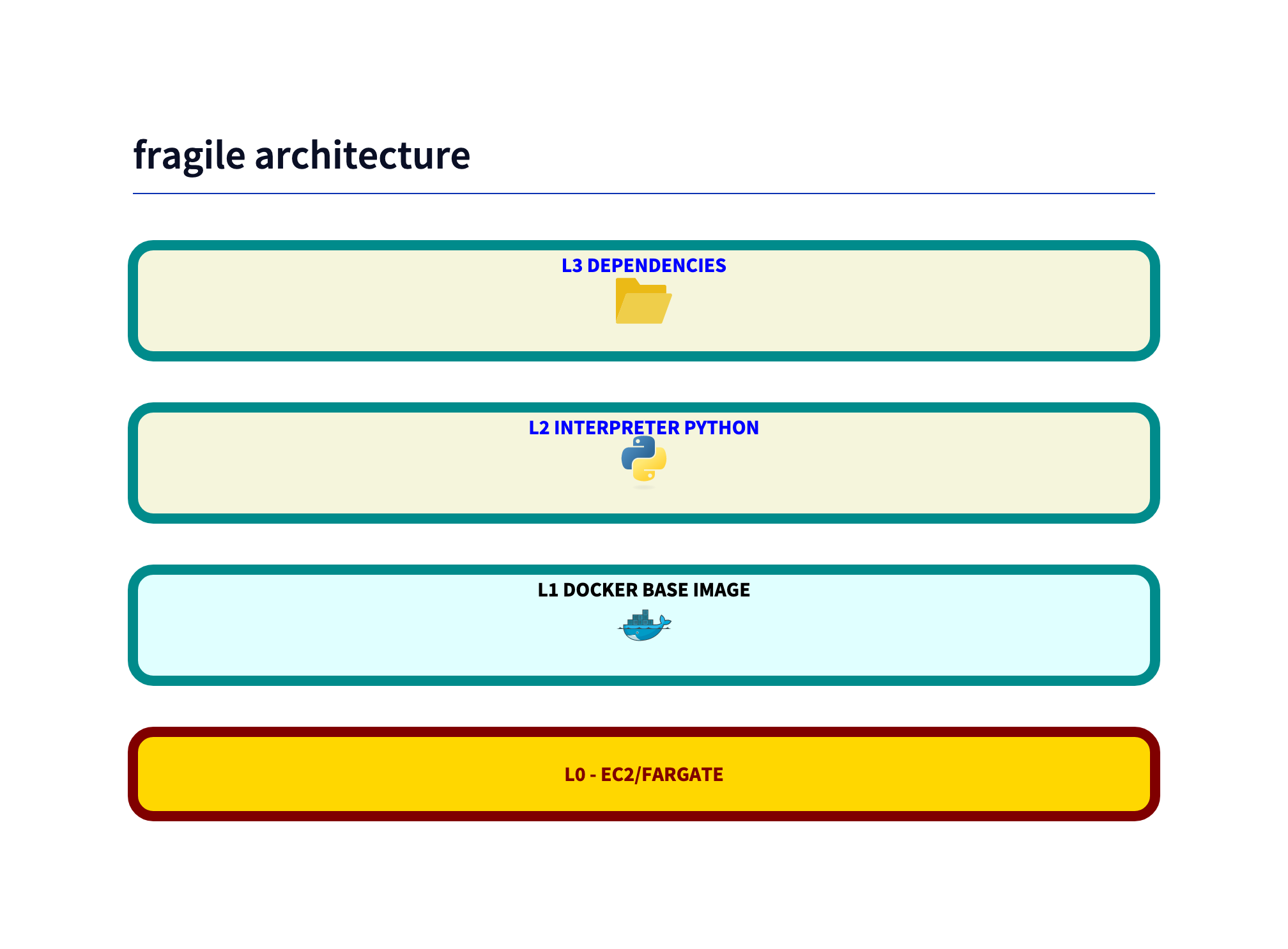
The Dockerfile is simple:
# app/Dockerfile
FROM --platform=linux/amd64 python:latest
WORKDIR /app
RUN apt-get update && apt-get install -y \
build-essential \
&& rm -rf /var/lib/apt/lists/*
COPY ./requirements.txt work/
WORKDIR /app/work
RUN pip install --no-cache-dir -r requirements.txt
WORKDIR /app
RUN mkdir work/images
COPY ./*.py work/
COPY ./*.yaml work/
WORKDIR /app/work
EXPOSE 8501
HEALTHCHECK CMD curl --fail http://localhost:8501/_stcore/health
ENTRYPOINT ["streamlit", "run", "app.py", "--server.port=8501", "--server.address=0.0.0.0"]
To run a simple streamlit app, you need a lot of dependencies.
Example requirements.txt:
altair==5.2.0
attrs==23.1.0
bcrypt==4.1.1
blinker==1.7.0
boto3==1.34.29
botocore==1.34.29
cachetools==5.3.2
certifi==2023.11.17
charset-normalizer==3.3.2
click==8.1.7
extra-streamlit-components==0.1.60
gitdb==4.0.11
GitPython==3.1.40
idna==3.6
importlib-metadata==6.11.0
Jinja2==3.1.2
jmespath==1.0.1
jsonschema==4.20.0
jsonschema-specifications==2023.11.2
markdown-it-py==3.0.0
MarkupSafe==2.1.3
mdurl==0.1.2
numpy==1.26.2
packaging==23.2
pandas==2.1.3
Pillow==10.1.0
protobuf==4.25.1
pyarrow==14.0.1
pydeck==0.8.1b0
Pygments==2.17.2
PyJWT==2.8.0
python-dateutil==2.8.2
pytz==2023.3.post1
PyYAML==6.0.1
referencing==0.31.1
requests==2.31.0
rich==13.7.0
rpds-py==0.13.2
s3transfer==0.10.0
six==1.16.0
smmap==5.0.1
streamlit==1.29.0
streamlit-authenticator==0.2.3
tenacity==8.2.3
toml==0.10.2
toolz==0.12.0
tornado==6.4
typing_extensions==4.8.0
tzdata==2023.3
tzlocal==5.2
urllib3==2.0.7
validators==0.22.0
zipp==3.17.0
To deploy a container in ECR (Elastic Container Registry), I use this Taskfile:
# https://taskfile.dev
version: "3"
vars:
REGION: "eu-central-1"
NAME: "fragile"
VERSION: "v0.1.1"
ACCOUNT:
sh: aws sts get-caller-identity --query Account --output text
tasks:
ecr-push:
desc: Build local image and Push to ECR, docker or colima must run before
cmds:
- task: docker-build
- task: docker-tag
- task: docker-login
- task: docker-push
docker-build:
desc: Docker build (1)
cmds:
- docker build -t {{.NAME}} .
docker-tag:
desc: Docker tag (2)
cmds:
- docker tag {{.NAME}}:latest {{.ACCOUNT}}.dkr.ecr.{{.REGION}}.amazonaws.com/{{.NAME}}:{{.VERSION}}
docker-login:
desc: Docker tag (3)
cmds:
- aws ecr get-login-password --region {{.REGION}} | docker login --username AWS --password-stdin {{.ACCOUNT}}.dkr.ecr.{{.REGION}}.amazonaws.com
docker-push:
desc: Docker tag (4)
cmds:
- docker push {{.ACCOUNT}}.dkr.ecr.{{.REGION}}.amazonaws.com/{{.NAME}}:{{.VERSION}}
create-ecr:
desc: Create ECR
cmds:
- aws ecr create-repository --repository-name {{.NAME}} --region {{.REGION}} --image-scanning-configuration scanOnPush=true
For the other architectures, you replace the NAME variable. Fun fact: It speaks for AWS stability, that I used these steps 6 years ago and they still work. I only traded Makefile for taskfile.dev.
Steps to deploy:
task create-ecrtask ecr-push
Scanning Prequesites:
- Activate Inspector on the AWS account
Fragile Vulnerabilities
The inspector is activated and the image is scanned:

OOPS, 2 critical vulnerabilities and 314 other.
Let’s analyse:
Level 1 - Base Image
With docker scout you get some insights about the base image:
docker scout quickview local://fragile
✓ SBOM of image already cached, 629 packages indexed
Target │ local://fragile:latest │ 0C 4H 8M 100L 1?
digest │ a4a879c6f9a8 │
Base image │ python:3 │ 0C 2H 7M 99L
Updated base image │ python:3-slim │ 0C 1H 1M 21L
│ │ -1 -6 -78
So a first step towards more security would be to use a slim version of the base image.
Level 2 - Python
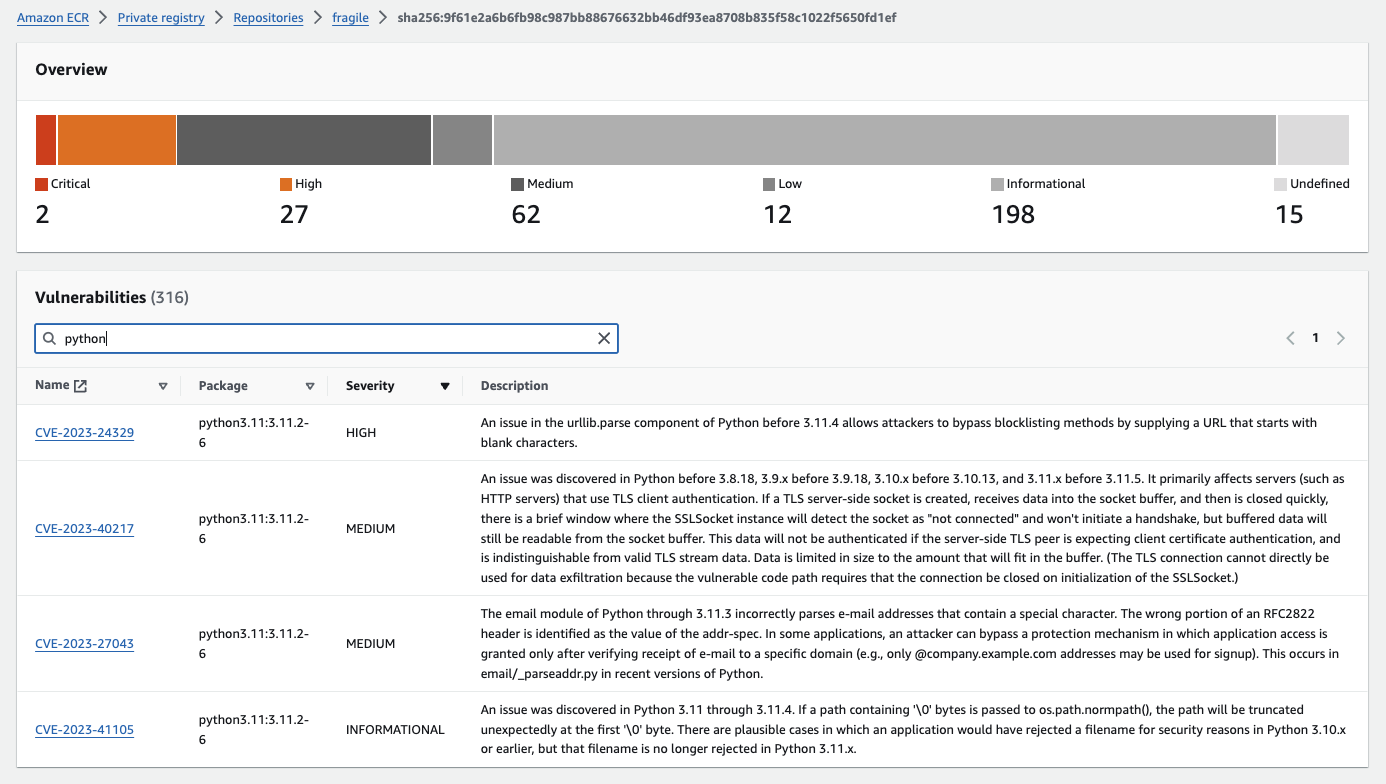
Lets look at the details of the first vulnerability:
| Name | Package | Severity | Description |
|---|---|---|---|
| CVE-2023-24329 | python3.11:3.11.2-6 | HIGH | An issue in the urllib.parse component of Python before 3.11.4 allows attackers to bypass blocklisting methods by supplying a URL that starts with blank characters. |
In the text you see, in which version the bug is fixed. What you also have to check is whether you really use the package in your code. If not, you can delay fix of the vulnerability.
To further analyse the vulnerabilities, you can click the Name: CVE-2023-24329 i the AWS console.
You see many things. Notworthy is, that using a new version of the interpreter is not always a way to fix the vulnerability:

So use a newer version, but keep scanning :) .
Sturdy - A more secure version
This example architecture splits the monolithic fragile architecture into a frontend and a backend. The frontend is a static website, serverd by nginx. For simplicity we assume the backend is written as Lambda. So its a bit unfair to compare the monolithic archicture, which contains front- and backend. Its only done to show the difference in the vulnerabilities and to have a good story ;) .
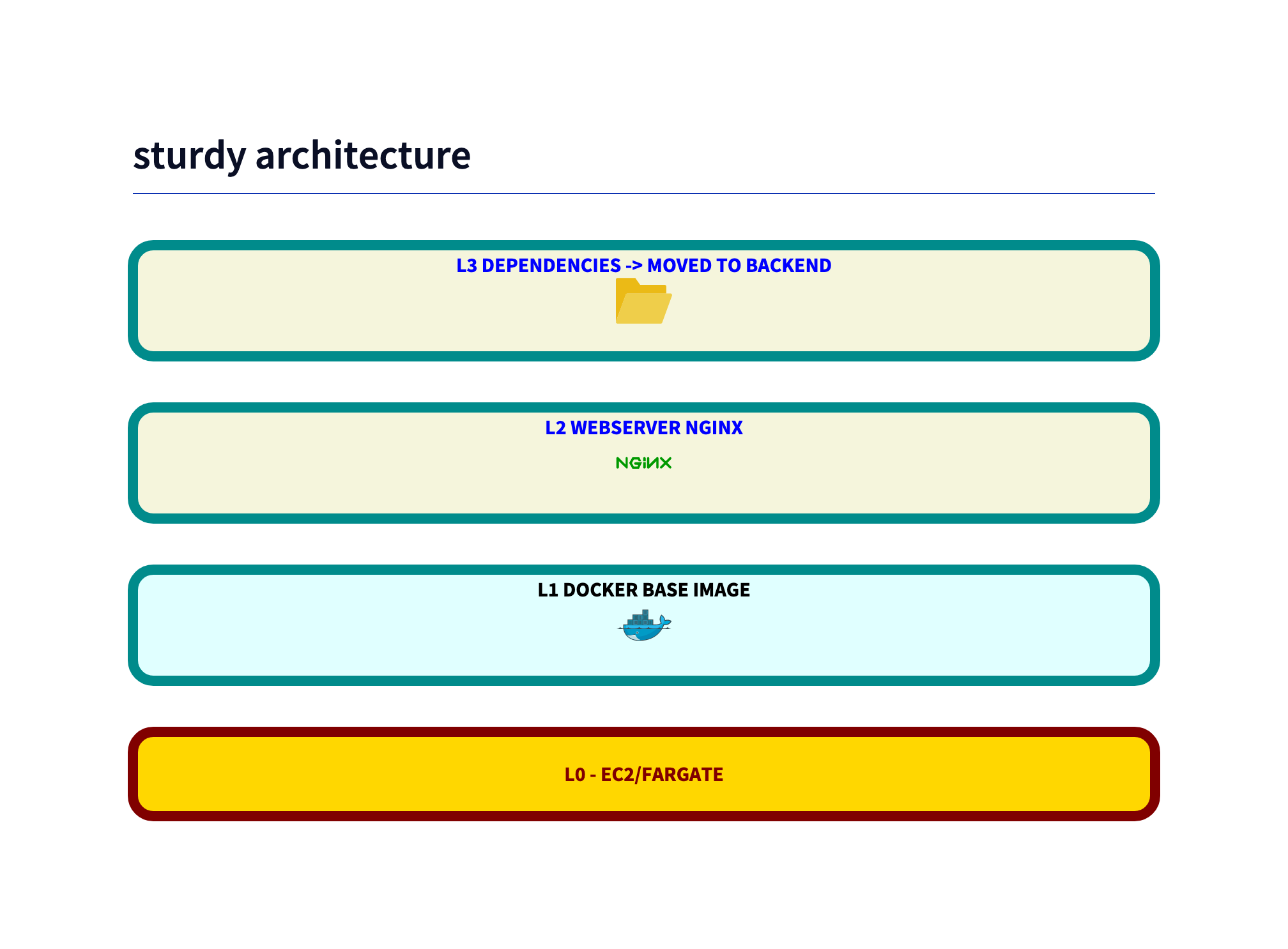
As an example, the Dockerfile just has nginx as base image:
FROM nginx
The hope is to get less vulnerabilities and the latest nginx version.
Sturdy Vulnerabilities
docker scout quickview local://sturdy
✓ Image stored for indexing
✓ Indexed 232 packages
Target │ local://sturdy:latest │ 0C 1H 2M 37L
digest │ 760b7cbba31e │
Base image │ debian:12-slim │ 0C 0H 0M 18L
Updated base image │ debian:stable-slim │ 0C 0H 0M 18L
Inspector also has some things to say:
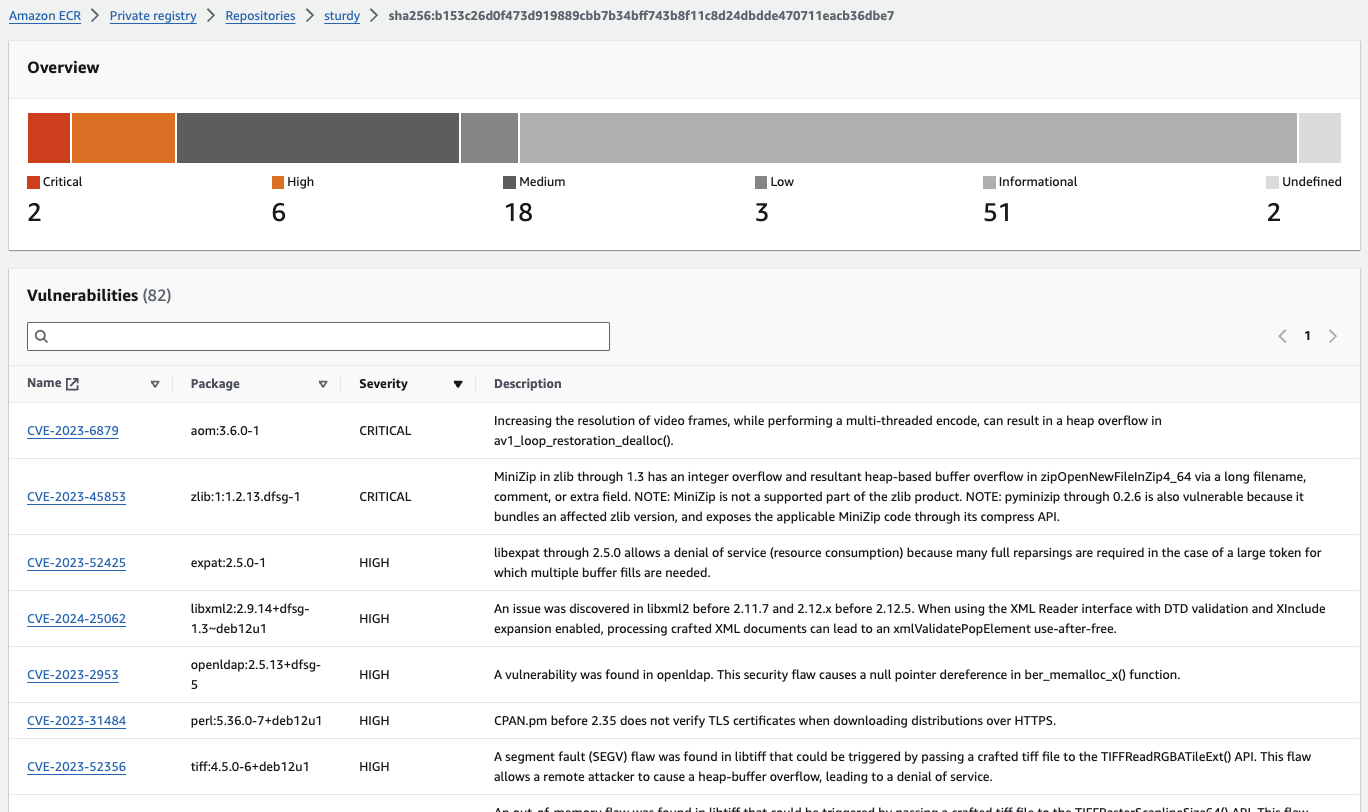
As Dante says: “Lasciate ogne speranza, voi ch’intrate” - “Abandon all hope, ye who enter here”.
So using a standard webserver without optimization does not help to reduce vulnerabilities.
Potent - build your own server
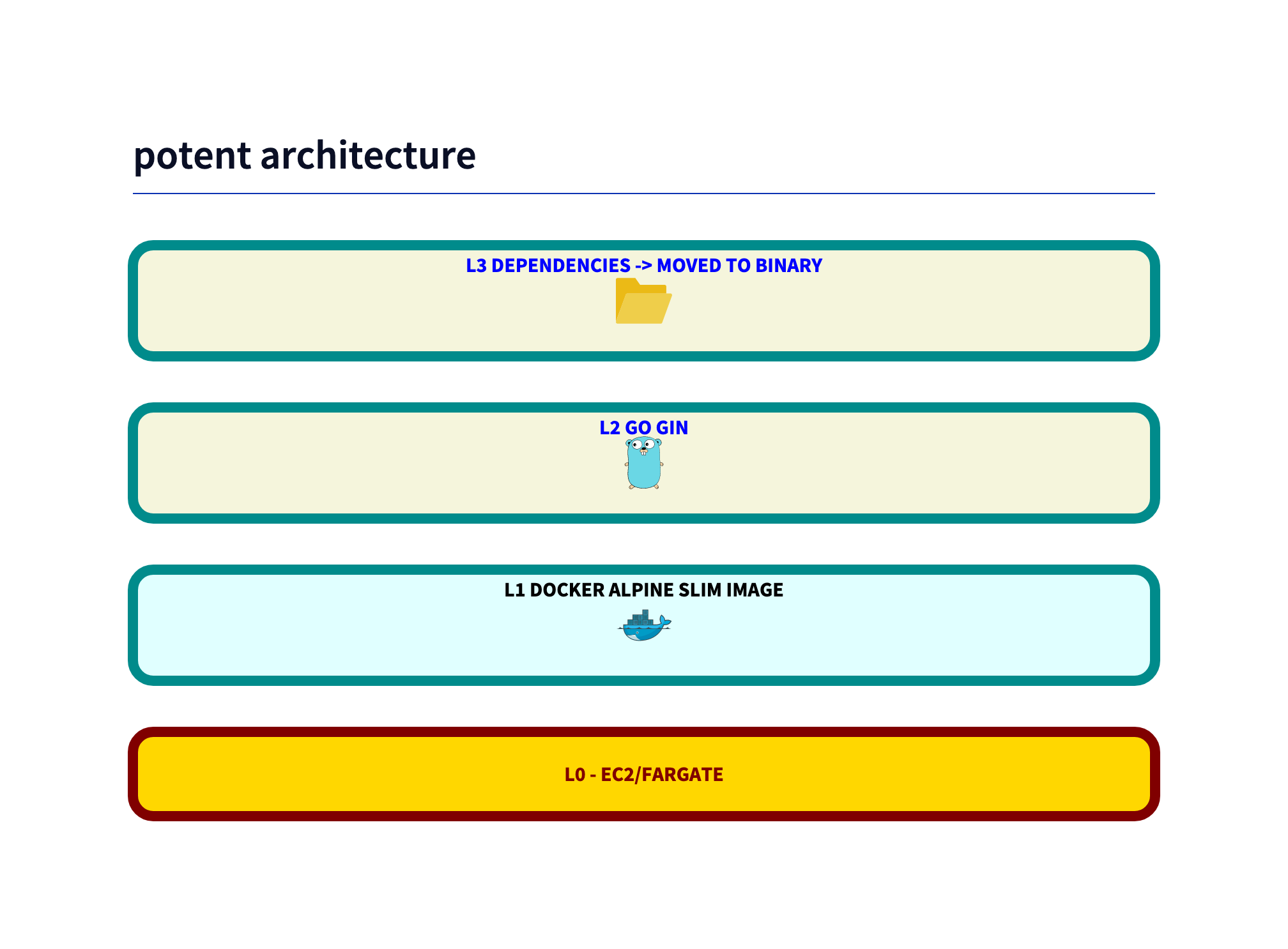
One road to zero vulnerabilities is to build your own server. The paradign shifts from “use frameworks and libraries” to “use as few libraries as possible”.
The Dockerfile is simple. The GO build itself is done independent of the base image dockerfile.
FROM alpine:latest
WORKDIR /app
COPY dist/server_linux server
EXPOSE 80
ENTRYPOINT ["./server"]
The base GO code uses a framework (Gin), you could also use the standard library. But as the scan shows, that is not needed as we are already have less vulnerabilities.
The main code is simple:
router := gin.Default()
// Middleware to protect sensitive routes
// Serve static files
authorized := router.Group("/", basicAuth)
authorized.StaticFile("/", "./public/index.html")
authorized.StaticFile("/asset-manifest.json", "./public/asset-manifest.json")
authorized.StaticFile("/manifest.json", "./public/manifest.json")
authorized.StaticFile("/favicon.ico", "./public/favicon.ico")
authorized.StaticFile("/index.html", "./public/index.html")
Here the app only serves single files, not all files. So the attack surface is reduced.
Potent Vulnerabilities
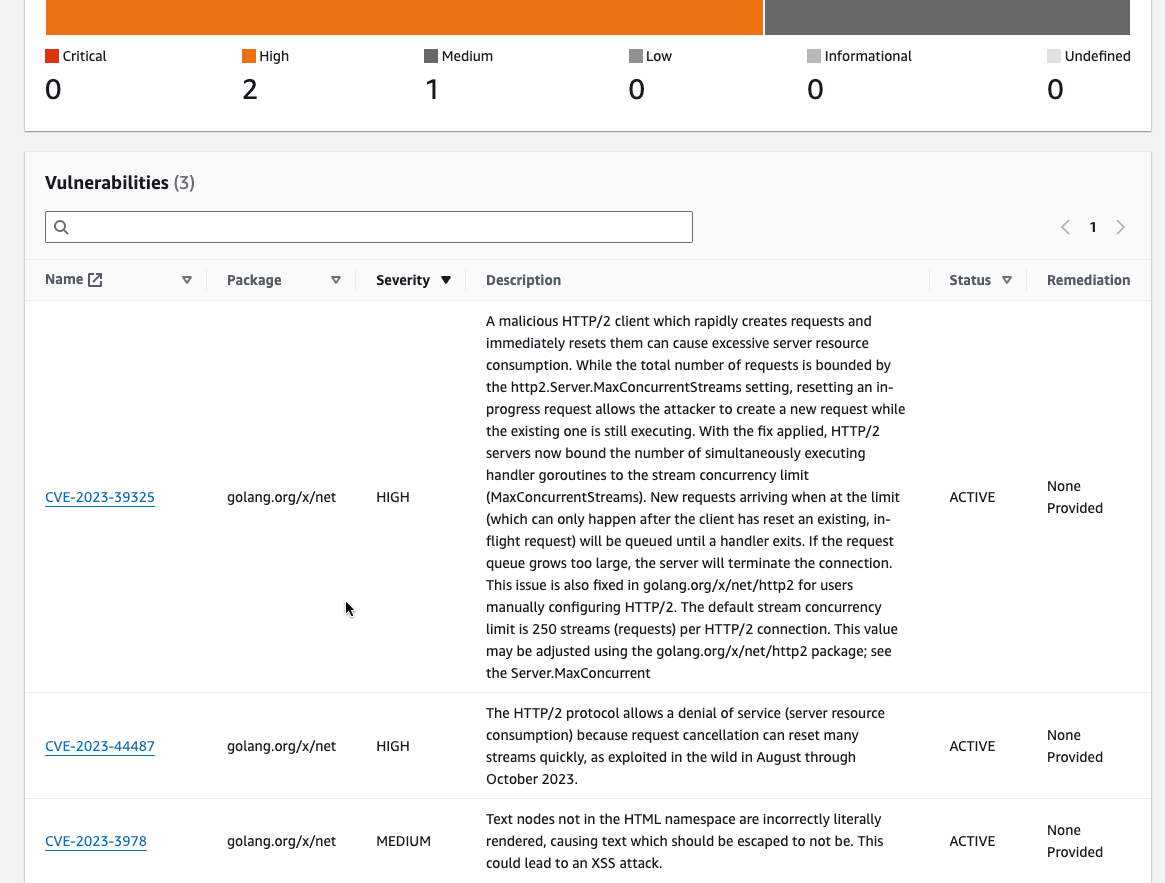
Because we used the minimal linux “alpine” the Level 1 vulnerabilities are (almost) gone.
With a static compiled binary, we do not need so much operating system libraries. So the attack surface is reduced.
Amazon Inspector directly shows the problem and the solution:
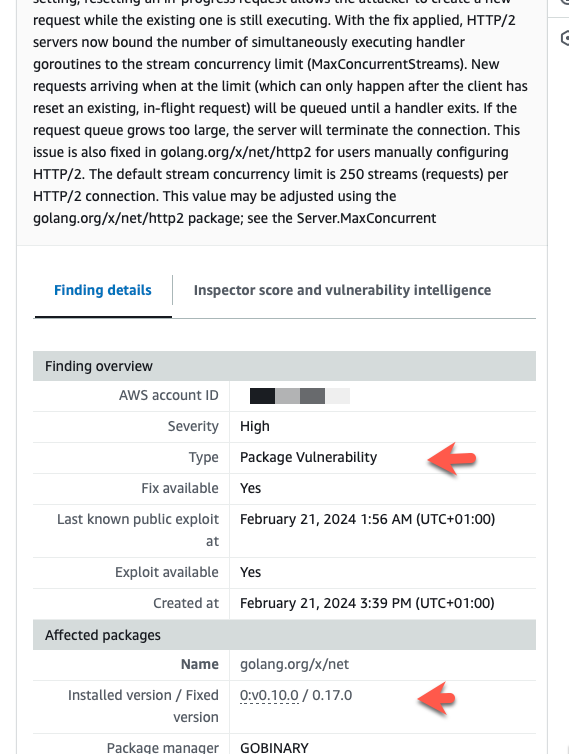
So update the library and we have zero vulnerabilities:

Time to party? Not yet. Scout shows vulnerabilities in the base image alpine:3.

Time for the last mile.
Formidable - Zero vulnerabilities

FROM alpine:3.19.1 as builder
WORKDIR /app
COPY dist/server_linux server
EXPOSE 80
ENTRYPOINT ["./server"]
ECR says zero vulnerabilities

Scout is also happy:

NOW it is time to party!
Summary
We learn two things:
Amazon Inspector is a great tool to find vulnerabilities not only in your Docker images. But for zero vulnerabilities you have to go the extra mile and use additional tools like Docker Scout.
The second thing is, that powerfull frameworks trade security for features. The attack surface is larger, so is the probability of vulnerabilities.
What’s next?
I do not talk about application induced vulnerabilities. Look for scanners in you development language. For example, in Go you can use govulncheck.
If you need AWS training, developers and consulting for your next cloud project, don’t hesitate to contact us, tecRacer.
Want to learn GO on AWS? GO here
Enjoy building!
Thanks to
Photo by camilo jimenez on Unsplash
- icon by Pham Duy Phuong Hung
